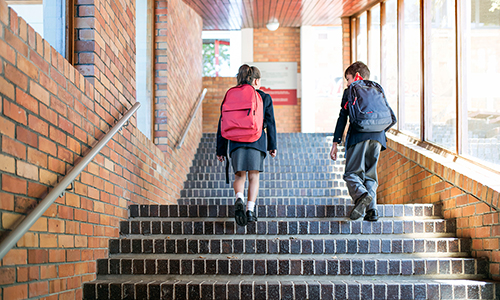Evaluating the unique risks to your campus and identifying any existing gaps that need to be addressed is fundamental to developing a comprehensive security and safety plan for your school.
No one set of physical security solutions is right for every campus or community. However, a layered, systems-based approach can help to detect, delay and respond to threats while also helping to avoid any single point of failure.
Think of layering security like concentric circles starting at the outer fringes or perimeter of your school campus and working toward the center. Each successive layer can include specific components that provide a protective element to hinder adversarial behaviors and delay an attack if other layers are bypassed or breached. Delaying an armed assailant can afford the critical time needed for first responders to manage the threat and take appropriate action.
Based on a summarization of recommendations from the Partner Alliance for Safer Schools (PASS) School Safety and Security Guidelines and the Cybersecurity & Infrastructure Security Agency (CISA), here are five proven ways to help assess building security layer-by-layer and better secure your school:
- Ensure compliance with district-wide physical security standards: Be sure you have deep understanding of and are consistently adhering to district-wide standards to establish recommended best practices, including frequent lockdown drills and regular training so everyone—from students to faculty—knows what to do in an emergency.
- Prioritize a layered approach to perimeter security: The physical security of a school facility begins at the property perimeter boundary, where the most outwardly visible security deterrents to an external threat can be implemented at playgrounds, sporting fields, parking lots and other facilities that are often used by the public after school hours end, and continue to build on protections moving inward.
- Build an interior layer of security to protect classrooms and other interior rooms: School building interiors are composed of everything within the school structure, including administrative offices, classrooms, restrooms, gyms, hallways and student centers or cafeterias. A coherent and clearly marked numbering system and signage for the entire building is a basic requirement to provide first responders directions to key areas of the school should an incident occur.
Many of the same measures used to detect, delay and respond to threats across the campus also apply to the interior, with access control systems at the top of the priority list.
- Implement effective mass notification systems and practices: During active shooter incidents or other emergencies, prompt notification is critical in saving lives. Quick announcement of a lockdown must be made in a clear, audible message to everyone on school property at the onset of an emergency. This requires, at a minimum, a working public address or PA system enhanced by newer technology innovations, including in-building emergency communications systems and mass notification solutions.
- Establish comprehensive video surveillance coverage: Video coverage of all interior and immediate exterior areas of buildings, especially where students and staff congregate, is a powerful tool to provide timely intelligence on circumstances around your campus.
Providing first responders access to video images means they can quickly assess and respond to any emergency and potentially pinpoint an assailant’s location, movements and possible hiding spots.
For a layered system to work best, school districts must ensure the right policies and procedures are in place and that school staff is knowledgeable on the correct actions to take in an emergency. This checklist shows how taking a layered, systems-based approach to physical security risk assessment can help schools create safe and secure learning environments without requiring school staff to become security experts or compromising the educational mission.














